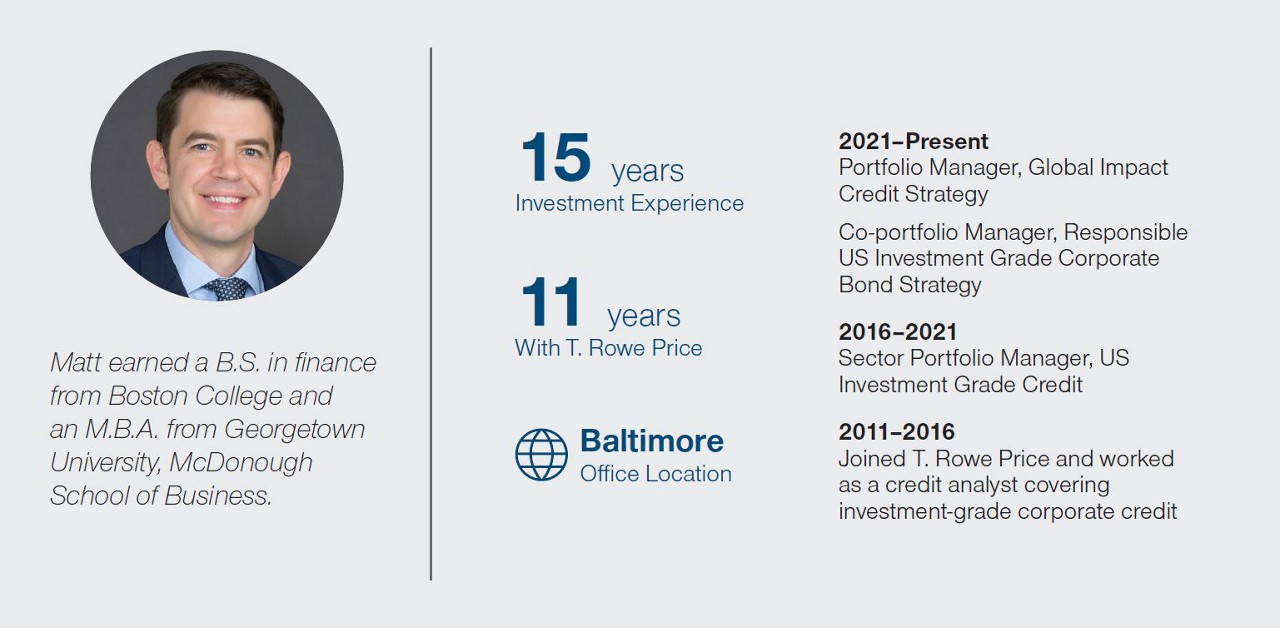June 2023 / INVESTMENT INSIGHTS
Meet Matthew Lawton
Portfolio Manager, Global Impact Credit Strategy

With more than a decade of experience analyzing investment‑grade bond credit quality and managing fixed income portfolios coupled with a passion for addressing climate change, Matt Lawton sees managing the Global Impact Credit Strategy as a way to combine the professional and personal. Matt uses the strategy’s flexibility to go beyond “green” bonds to research debt from a range of issuers that can help address environmental and social problems. The strategy’s dual objectives are to pursue environmental and social impact and investment return.
Tell us about your background and what informed your decision to pursue a career in asset management.
After finishing my bachelor’s degree, I knew that I wanted to work in finance but wasn’t sure which segment of the industry I would enjoy the most. I spent four years in investment banking in New York City before deciding that it wasn’t for me and applying to business school.
During my time pursuing an M.B.A. at Georgetown University, I completed a summer internship with T. Rowe Price in fixed income research. As an intern, I worked on the emerging market credit team, focusing on Latin American utilities. I was fortunate enough to travel to Brazil to meet several management teams, regulators, and development bank officials, which was an exceptional opportunity for an intern. That summer experience applying my analytical skills to examine issuer credit quality sold me on the asset management business in general and on T. Rowe Price in particular.
How did you determine your area of specialization, and what makes your experience well suited to pursue the core objectives of the strategy?
Climate change issues are near and dear to me, so managing the Global Impact Credit Strategy is an ideal way to combine a professional pursuit with my personal interests. I see this as a sort of parallel with the strategy’s dual core objectives of pursuing environmental and social impact as well as financial return.
I was a corporate credit analyst for six years, which provided a foundational understanding in analyzing issuer credit quality and value relative to that quality. I then transitioned into a sector portfolio manager role, which built upon that fundamental foundation with added perspectives on macroeconomics, cross‑sector relative value, and risk management. The key to success in both roles was effective collaboration—with other credit analysts, portfolio managers, and equity analysts. Deep collaboration is a necessary component of being a successful debt investor; collaboration in general is an important part of the culture at T. Rowe Price. As the Global Impact Credit Strategy portfolio manager, I’ve been fortunate to further broaden my network to include responsible investing analysts and impact portfolio managers across asset classes.
Discuss your approach and how you aim to generate value on behalf of clients. Explain how you’ll tap in to T. Rowe Price’s research platform and other resources to pursue results.
In‑depth fundamental research is a cornerstone of T. Rowe Price’s investment process across all asset classes, and it is particularly important in an impact strategy. Credit research is one of the four pillars that anchor our management of the strategy. An issuer that could experience a precipitous decline in credit quality would compromise our ability to advance either of the strategy’s core objectives.
Materiality and measurability of positive impact is another pillar. We strive to quantify social and environmental impact outcomes and to account for positive future change. This is achieved through in‑depth impact research.
We also believe that sustainability matters. What we mean by this is that companies driving positive environmental or social impact have an advantage from the perspectives of capital markets, competitive position, and, ultimately, economic returns. This pillar pulls together the perspectives brought forth by both the fundamental and impact research teams.
The fourth pillar is additionality, where we can apply T. Rowe Price’s scale and resources to help advance and promote an issuer’s impact. One of the ways that we can do this is through direct engagement with management teams.
How does this strategy compare and contrast with others in market?
With significant media attention on “greenwashing,” or environmental, social, and governance (ESG) investing strategies that are green in name only, investors naturally have questions about the substance of a strategy’s investment process. In our view, most other ESG strategies—particularly in fixed income—take a lighter‑touch approach, relying on exclusions or third‑party ESG ratings. In the Global Impact Credit Strategy, every company in our portfolio is subject to rigorous and inclusionary screening as well as a comprehensive analysis of the environmental or social impact it is delivering. We believe this positively differentiates our approach relative to other products in the marketplace.
Unlike green bond strategies, which only invest in bonds that the issuer labels as “green,” we flexibly look to a broader opportunity set spanning the credit universe, identifying issuers that are seeking to deliver material and measurable positive environmental or social impact—whether or not the bonds are green.
Describe how the portfolio is positioned as well as your outlook.
Our investment approach aligns with the United Nations Sustainable Development Goals (SDGs) by evaluating impact across three pillars and eight sub-pillars that encompass: (1) Climate and Resource Impact, (2) Social Equity and Quality of Life, and (3) Sustainable Innovation and Productivity.*
Over this first phase of the strategy’s life, we have been heavily weighted toward the Climate and Resource Impact and Social Equity and Quality of Life pillars as we believe they offer the highest degree of direct, positive impact. The two pillars, in combination, have accounted for over 90% of strategy assets as of May 31, 2023. While our SDG alignment continues to favor #7 (Affordable and Clean Energy) and #3 (Good Health and Well-Being), we are continually looking to diversify our SDG alignment.
The majority of holdings within the Climate and Resource Impact segment sit within our Reducing Greenhouse Gases sub-pillar, including real estate and power utility companies. We hold small allocations to our other climate-focused sub-pillars, which are Nurturing Circular Economies and Promoting Healthy Ecosystems. In the latter, we were excited to purchase our first blue bond in the first quarter of 2023.
Within the Social Equity and Quality of Life pillar, we have three sub-pillars, with the Improving Health subsegment holding the majority of our positions. Here, we look for companies within the health care ecosystem that improve the pace of innovation, reduce costs, or meaningfully change patient outcomes. We continue to feel positive about companies exposed to the acceleration of the pandemic’s health response efforts, as well as the need to provide catch-up procedures that were postponed during lockdowns in many countries. Elsewhere in this pillar, we have a slightly smaller presence in the Enabling Social Equity sub-pillar, which encompasses companies that enable access to education, consumption at the bottom of the pyramid, and financial inclusion—within both emerging and developed markets. Examples include financial service providers that are improving financial inclusion among developed market consumers.
The third pillar, Sustainable Innovation and Productivity, remains relatively small but has grown over time. This is distributed across two sub-pillars, namely Sustainable Technology and Building Sustainable Industry and Infrastructure.
Share with us your personal interests and how they might (or might not) intersect with your professional work.
I strongly believe in the importance of having balance outside of your job to succeed and to have rewarding experiences both at and outside of work. I have a young daughter with a range of interests, and I find grounding in supporting her pursuit of those interests. I also seek balance through exercise, which I find rewarding for the mental health benefits as much as the physical.
I also enjoy traveling and have been pleased to resume this since the lifting of COVID restrictions. Traveling is a great way to build a global mindset and sense of perspective, so in that sense, it provides benefits from both a personal and professional point of view.
Positioning in the pillars discussed on this page is as of May 31, 2023 and is subject to change.
General Fixed Income Risks
Capital risk—the value of your investment will vary and is not guaranteed. It will be affected by changes in the exchange rate between the base currency of the portfolio and the currency in which you subscribed, if different.
ESG and sustainability risk—may result in a material negative impact on the value of an investment and performance of the portfolio.
Counterparty risk—an entity with which the portfolio transacts may not meet its obligations to the portfolio.
Geographic concentration risk—to the extent that a portfolio invests a large portion of its assets in a particular geographic area, its performance will be more strongly affected by events within that area.
Hedging risk—a portfolio’s attempts to reduce or eliminate certain risks through hedging may not work as intended.
Investment portfolio risk—investing in portfolios involves certain risks an investor would not face if investing in markets directly.
Management risk—the investment manager or its designees may at times find their obligations to a portfolio to be in conflict with their obligations to other investment portfolios they manage (although in such cases, all portfolios will be dealt with equitably).
Operational risk—operational failures could lead to disruptions of portfolio operations or financial losses.
IMPORTANT INFORMATION
This material is being furnished for general informational and/or marketing purposes only. The material does not constitute or undertake to give advice of any nature, including fiduciary investment advice, nor is it intended to serve as the primary basis for an investment decision. Prospective investors are recommended to seek independent legal, financial and tax advice before making any investment decision. T. Rowe Price group of companies including T. Rowe Price Associates, Inc. and/or its affiliates receive revenue from T. Rowe Price investment products and services. Past performance is not a reliable indicator of future performance. The value of an investment and any income from it can go down as well as up. Investors may get back less than the amount invested.
The material does not constitute a distribution, an offer, an invitation, a personal or general recommendation or solicitation to sell or buy any securities in any jurisdiction or to conduct any particular investment activity. The material has not been reviewed by any regulatory authority in any jurisdiction.
Information and opinions presented have been obtained or derived from sources believed to be reliable and current; however, we cannot guarantee the sources’ accuracy or completeness. There is no guarantee that any forecasts made will come to pass. The views contained herein are as of the date written and are subject to change without notice; these views may differ from those of other T. Rowe Price group companies and/or associates. Under no circumstances should the material, in whole or in part, be copied or redistributed without consent from T. Rowe Price.
The material is not intended for use by persons in jurisdictions which prohibit or restrict the distribution of the material and in certain countries the material is provided upon specific request. It is not intended for distribution to retail investors in any jurisdiction.
